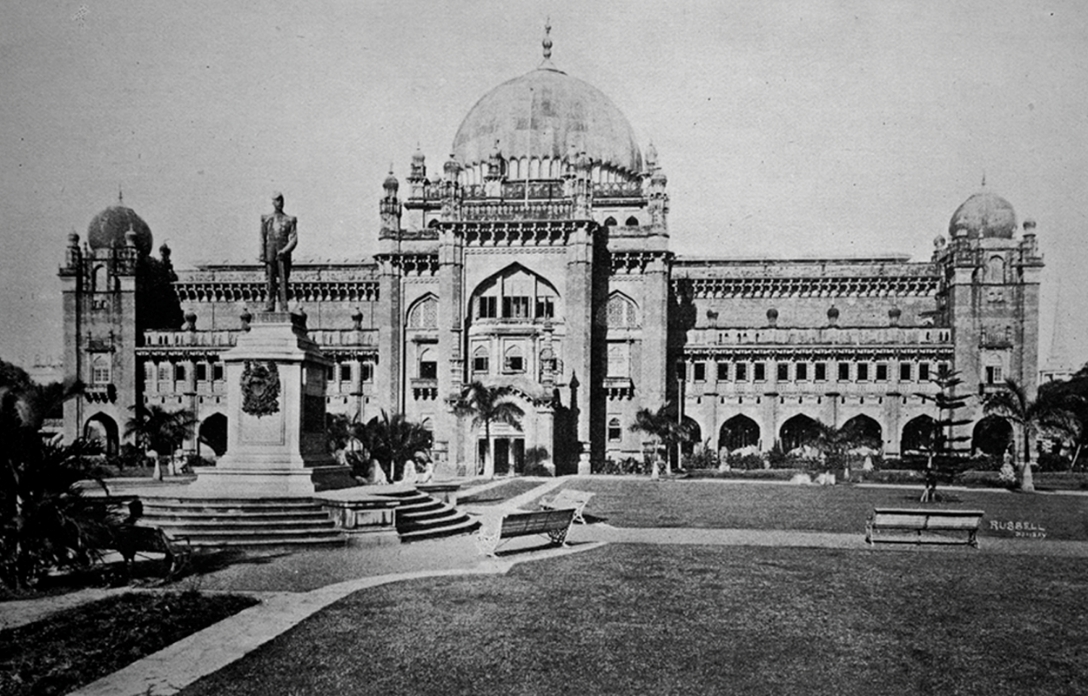History
‘The Museum of Western India composition.
The real reason why it is so, is because it was instructed that the design should be indian in character…’ – George Wittet

Founded in the early 1900s, Chhatrapati Shivaji Maharaj Vastu Sangrahalaya is one of the foremost cultural institutions in the country. On the 14th of August 1905, a number of prominent citizens of Bombay gathered at the Town Hall. They resolved to erect a Memorial to the visit of the Prince of Wales (later King George V) in the form of a public museum. The meeting was attended by Sir Pherozeshah Mehta, Justice Badrudin Tyabji, Narotamdas Gokuldas, Justice Chandavarkar, Sassoon J. David and many other dignitaries who were known for their outstanding contribution in their respective fields ,and also in the development of the island of Bombay. The Foundation Stone of the Museum was laid by the Prince of Wales on the 11th of November, 1905 and the Museum was named Prince of Wales Museum of Western India. The Museum was a culmination of the desire of Mumbai’s public for the construction of a Museum that could represent their cultural heritage. Consequently, the institution was established through public contribution aided by the then Government of the Bombay Presidency.
This memorial in the form of a museum was to be erected on a plot of land known as the ‘Crescent Site’ on the southern tip of the island. The building was completed in 1914, but opened its doors to the public much later on the 10th of January, 1922. Until then it was used by the military as a hospital and for Children’s Welfare Exhibitions.
Many things have changed since then. Bombay is now known as Mumbai and the name of the Prince of Wales Museum of Western India is changed to the Chhatrapati Shivaji Maharaj Vastu Sangrahalaya. Set against a well laid out garden which retains its original plan till this date, the museum is an important Heritage building of the city.
Architecture

Chinese and Japanese Art Gallery in 1928
It is a Grade I Heritage Building of the city and is set in a well laid out garden which retains its original plan. It has been awarded first place for Heritage Building Maintenance by the Indian Heritage Society.
The architect of the building, George Wittet, was selected after an open competition in 1909. Wittet is known for the Indo-Saracenic style of architecture of which this museum is one of the best examples. The Indo-Saracenic style combines Hindu and Saracenic architectural forms, at times incorporating some elements of Western architecture. The Indian pillared hall, the arched pavilion, the dome rising above the huge intersecting arches forming a beautiful geometrical pattern-all these together make the Museum building a typical example of the Indo-Saracenic style. Small jalis for light and wind add to the grandeur of the building. George Wittet skilfully incorporated the original wooden arched pavilion purchased from a royal house (wada) at Nasik in Maharashtra, as a circular railing on the first floor of the building. The dome of this building is designed after the Gol Gumbaz of Bijapur and the finial is copied from the Taj at Agra.
Today, CSMVS houses approx. 70,000 artefacts and has an outstanding collection comprising sculptures, terracottas, bronzes, excavated artefacts from Indus Valley sites, Indian miniature paintings, Indian decorative arts, European paintings and decorative arts, porcelain and ivories from China and Japan, etc. Besides these, the Museum has separate sections of Numismatics and Natural History
Milestones
August 14,1904
The need for having a public museum in Bombay (now Mumbai) was recognised by some of its eminent citizens and proposed to the Government of Bombay Presidency. A resolution was passed and the first Museum Committee was appointed by the Government.
November 11, 1905
The foundation stone of the Museum building was laid by HRH the Prince of Wales, and the Museum was named as the ‘Prince of Wales Museum of Western India’.
1909
The Board of Trustees which represents major stakeholders of culture in the city, was constituted through an Act to oversee the running of the Museum.
1909
George Wittet, a Scottish architect, was selected through an open competition to design the Museum building.
1914
Construction of the magnificent building, which is an excellent example of Indo-Saracenic architecture, was completed. This architectural style encompasses elements from Hindu, Islamic and Western architecture.
1914
During World War I, the Museum building was used as a military hospital and named Lady Hardinge War Hospital. The building was once again used as a major hospital during the influenza pandemic in 1918-1920.
1920
The building was handed over to the Trustees of the Museum. They continued collecting objects of art and archaeology through generous gifts and purchases.
January 10, 1922
The Museum was formally opened to the public.
October 28, 1933
The foundation stone for the Extension Wing was laid, and it was opened to the public in 1938.
1942 to 1946
The Museum’s building (heritage wing) was given to Red Cross Society during World War II on the request of the Government.
In the following decades, the Museum has flourished as a leading cultural institution owing to its dynamic approach.
1990
The Museum was declared Grade I Heritage Building, acknowledging it as the heritage of national importance.
2001
The Museum was renamed Chhatrapati Shivaji Maharaj Vastu Sangrahalaya (CSMVS).
2010
The Museum received the UNESCO-Asia Pacific award for Commendable Conservation of the Building.
October 10, 2015
Museum on Wheels project was launched.
2018
The Museum has been declared as a UNESCO World Heritage site, part of the Victorian Gothic and Art Deco Ensemble in Mumbai.
March 19, 2019
The city’s first Children’s Museum was opened to the public.
January 2020
Museum on Wheels Bus 2 was launched.
January 10, 2022
The Museum completed 100 years of its glorious journey.